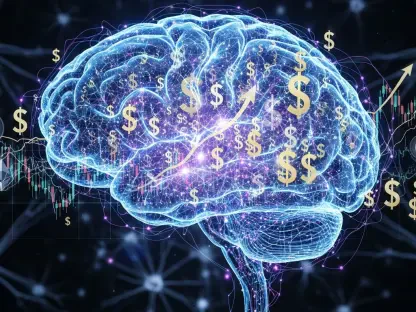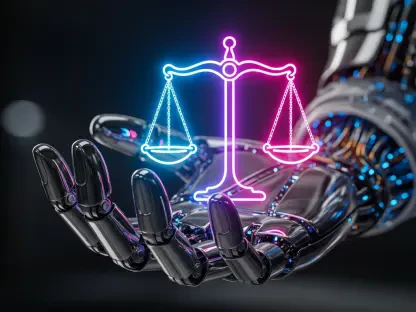Overview of a Pressing Challenge
The civil justice system in America stands at a critical juncture, where millions of low-income individuals face insurmountable barriers to legal representation, leaving them vulnerable in crucial matters. According to a comprehensive report by the Legal Services Corporation in 2022, a staggering 92 percent of these individuals receive inadequate or no legal assistance for civil matters. This gap leaves countless families exposed during disputes over housing, domestic issues, or consumer rights, often resulting in life-altering consequences like eviction or financial ruin. The absence of a constitutional right to counsel in civil cases—unlike in criminal matters—exacerbates this crisis, impacting roughly 50 million Americans living below 125 percent of the poverty threshold. This stark reality demands innovative solutions to ensure equitable access to justice.
The potential of artificial intelligence (AI) emerges as a beacon of hope amidst this systemic failure. With technology already reshaping various industries, its application in legal aid could offer affordable, scalable support to those most in need. This report examines how AI is beginning to address the civil justice gap, the benefits it brings, the risks it poses, and the regulatory frameworks necessary to guide its responsible use. By exploring current trends and future possibilities, the aim is to assess whether AI can truly transform access to justice for low-income Americans.
Understanding the Civil Justice Gap in America
The civil justice gap represents a profound inequality within the American legal system, where low-income individuals are systematically denied adequate representation. Unlike criminal defendants, who are guaranteed counsel under the Sixth Amendment, those facing civil disputes have no such protection. This leaves millions without guidance in matters that can determine their stability, such as landlord-tenant conflicts or child custody battles, often leading to devastating personal outcomes.
Data paints a grim picture of the scale of this issue. The Legal Services Corporation’s findings reveal that the vast majority of low-income individuals—92 percent—lack sufficient legal aid when navigating civil challenges. With approximately 50 million Americans living below 125 percent of the poverty line, the absence of support translates into widespread vulnerability, perpetuating cycles of poverty and instability.
The consequences of this gap extend beyond mere statistics, manifesting as personal crises. Unrepresented individuals risk losing their homes, facing unfair debt collection, or enduring family separations without the tools to defend their rights. Addressing this disparity is not just a matter of policy but a moral imperative, prompting exploration into non-traditional solutions like technology to fill the void left by an overburdened system.
The Potential of AI in Addressing Legal Disparities
Current Applications and Benefits of AI in Legal Aid
AI is already making inroads into the legal aid sector, offering a glimpse of its transformative potential. A recent study published in a prominent law review indicates that 21 percent of legal aid professionals currently utilize AI tools for routine tasks. These include drafting standard forms, composing correspondence, and simplifying complex legal terminology into accessible language, thereby reducing the time and cost associated with basic legal support.
Specific applications of AI demonstrate its value as a resource for the underserved. Tools like AI-powered chatbots can explain lease agreements, guide users through court paperwork, or provide initial advice on common issues. Such innovations act as a form of legal triage, screening cases to identify when professional intervention is necessary and ensuring that limited human resources are allocated efficiently.
The cost-reduction aspect of AI cannot be overstated. By automating repetitive tasks, technology enables legal aid organizations to stretch their budgets further, reaching more individuals who otherwise could not afford assistance. This scalability positions AI as a vital tool in narrowing the justice gap, provided its implementation is handled with precision and care.
Market Insights and Growth Potential for AI in Legal Services
The adoption of AI within the legal field is on an upward trajectory, reflecting broader industry trends toward digital transformation. Surveys, such as those conducted by Bloomberg Law on legal operations and technology, highlight a growing acceptance of AI tools among professionals. This shift is not about replacing attorneys but rather reorganizing workflows to enhance efficiency and accessibility.
Looking ahead, projections suggest that AI will play an increasingly central role in legal services over the next few years, from 2025 to 2027. Its integration into legal aid systems could expand the reach of basic support, particularly for routine matters that do not require nuanced human judgment. This reorganization may redefine roles within the sector, allowing professionals to focus on complex cases while technology handles foundational tasks.
Thoughtful integration remains key to realizing AI’s full potential. If designed with equity in mind, AI could democratize access to legal resources, ensuring that low-income individuals receive at least preliminary guidance. The market’s evolution will depend on balancing innovation with safeguards to prevent misuse or overreliance on automated systems.
Challenges and Risks of AI in Legal Contexts
Despite its promise, AI in legal contexts carries significant risks that must be acknowledged. One of the most pressing issues is the phenomenon of “hallucinations,” where AI tools generate inaccurate or fabricated information with misplaced confidence. Research indicates error rates in large language models ranging from 58 to 88 percent, posing a grave threat when applied to legal advice.
The consequences of relying on faulty AI outputs can be severe, especially in civil matters where decisions may lead to fines, loss of property, or even incarceration in extreme cases. For individuals without the means to verify or challenge AI-generated advice, such errors could compound their vulnerability rather than alleviate it. This underscores the limitations of current technology in handling sensitive legal issues.
A broad consensus exists that AI should serve as a complementary tool rather than a substitute for human expertise. In high-stakes or intricate civil cases, the nuances of law and personal circumstances demand professional judgment that machines cannot replicate. Additionally, there is a risk of deepening inequalities if AI tools are not equitably designed or accessible, potentially leaving marginalized groups further disadvantaged.
Regulatory Needs for Responsible AI Use in Legal Aid
The deployment of AI in legal aid necessitates robust oversight to mitigate harm from erroneous outputs. Without strict guidelines at every jurisdictional level, there is a danger that AI could perpetuate misinformation, undermining trust in the justice system. Regulatory frameworks must prioritize accuracy and ethical use to protect vulnerable populations who rely on these tools.
Balancing innovation with protection is a critical challenge for policymakers. Regulations should encourage the development of AI solutions while imposing clear standards for testing and validation before deployment. This approach ensures that technology serves as a force for equity, rather than a source of additional disparity in an already unequal system.
Compliance with regulatory standards will inevitably shape the pace of AI adoption in legal aid. Developers and organizations must navigate these requirements, which could influence the cost and timeline of implementing new tools. However, such oversight is essential to safeguard users and maintain the integrity of legal support services in the long term.
Future Outlook: AI’s Role in Transforming Access to Justice
Looking toward the horizon, AI’s long-term impact on the legal field could reshape traditional roles and structures. Junior attorneys, for instance, may find their responsibilities evolving as routine tasks are automated, freeing them to focus on strategic or interpersonal aspects of law. This shift hints at a broader industry reorganization, where technology and human expertise coexist in redefined capacities.
Emerging innovations, such as advanced natural language processing and machine learning algorithms, promise to enhance AI’s effectiveness in legal aid. These developments could improve the accuracy of automated advice and expand the range of issues AI can address. Yet, their success will hinge on addressing current limitations and ensuring widespread accessibility to avoid creating new barriers.
External factors, including economic conditions and public trust in technology, will also influence AI’s trajectory in narrowing the justice gap. Economic downturns may increase demand for affordable legal solutions, while skepticism about AI’s reliability could slow adoption. A cautious optimism is warranted, emphasizing the need for human oversight alongside technological advancements to maximize benefits and minimize risks.
Reflecting on Findings and Next Steps
This exploration into AI’s potential to bridge the civil justice gap for low-income Americans revealed a landscape of both opportunity and caution. The dire state of access to legal representation, where millions face critical disputes without aid, underscored an urgent need for change. AI emerged as a cost-effective ally for routine tasks, yet its high error rates demanded vigilance to prevent harm.
Actionable steps forward include the development of stringent regulations to govern AI’s use in legal contexts, ensuring accuracy and ethical deployment. Stakeholders are encouraged to prioritize equitable design, making tools accessible to all, while maintaining human oversight for complex matters. These measures aim to harness technology’s strengths without compromising the integrity of justice.
Future considerations point toward fostering public trust through transparency and continuous improvement of AI systems. Collaboration between technologists, legal professionals, and policymakers proves essential in crafting a system where innovation supports rather than supplants human judgment. By taking these steps, the groundwork is laid for a more inclusive legal landscape, addressing a long-standing inequity with thoughtful integration of technology.









